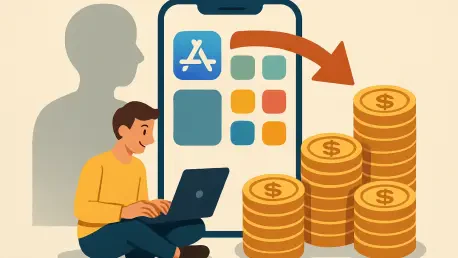Promises of cheaper apps, leaner fees, and a thriving marketplace of third‑party stores sounded like a clean win for consumers, yet the reality that unfolded across Europe shows a subtler shift where lower commissions largely padded developer margins while everyday users faced more choices with fewer clear benefits. The policy case centered on pass‑through: cut platform fees, spark competition, and watch prices fall. That narrative resonated because it felt intuitive and easy to measure.
Industry voices now parse early outcomes with a sharper eye. Consumer advocates focus on what users actually pay, noting that headline prices barely moved; platform analysts point to privacy and safety costs that seldom appear in app price tags; and independent developers weigh new distribution options against fragmented rules and support headaches. The common thread is a growing recognition that outcomes hinge less on fee schedules and more on demand, trust, and operational friction.
Several sources converge on a pointed view: savings are sticking with developers—often outside the EU—while new risks and hidden service costs land on users and Apple. A few developer groups counter that time will bring competitive discipline and non‑price gains, but even they concede that, so far, price relief is the exception, not the rule.
Following The Money Across Europe’s New iOS Rulebook
Price Pass-Through Fizzles: What Analysis Group Says—And What It Means
Market researchers cite Apple‑commissioned work from Analysis Group reporting that leading EU adopters of alternative terms kept flagship prices unchanged, and that developers maintained or raised prices for 91% of products covering 94% of transactions. Consumer groups interpret this as confirmation that demand, not distribution cost, sets the ceiling, so cheaper pipes do not mean cheaper water. In their view, the much‑debated commission cut simply changed who pockets the margin.
Economists add historical context: when Apple’s Small Business Program halved commissions for many small developers, fewer than 5% lowered prices. Pricing teams often benchmark to perceived value, competitive positioning, and churn risk, not to fees buried in back‑end ledgers. Regulators predicted pass‑through; practitioners highlight willingness to pay and the stickiness of subscription anchors. That clash explains why the theory of lower prices collided with the practice of keeping them steady.
Developers Capture The Margin: Who Benefits And Why Demand Sets The Ceiling
Cross‑border publishers with strong brands emerge as the primary winners, with multiple analyses estimating that roughly 86% of commission savings accrued to non‑EU developers. Retail pricing in marquee subscriptions and top‑grossing games reflects value perception and network effects; distribution costs are marginal in those decisions. Large studios and platforms leverage scale, marketing muscle, and deep catalogs to convert lower fees into profit, not price cuts.
Smaller EU developers describe a narrower window. Some enjoy modest breathing room for UA spend or payroll, but they report little power to spark price‑led competition against entrenched giants. Competition scholars warn that this pattern can entrench incumbents: fee relief helps those already able to command demand, while discovery remains the chokepoint for newcomers. In short, margin flows uphill.
Security, Privacy, And UX Trade-Offs In A Fragmented App Supply Chain
Security researchers note an expanded attack surface: more storefronts, installers, payment flows, and update paths introduce new vectors for fraud, sideloaded malware, and gray‑market plugins. Apple’s baseline is consistent; alternative stores present uneven governance, review rigor, and telemetry, creating uncertainty about what protections actually apply. Users encounter more prompts and permissions with fewer familiar trust signals.
Privacy advocates argue that consent fatigue worsens when stores use differing disclosure templates and billing flows. Meanwhile, UX specialists underscore a fragmented journey—installs, refunds, and updates can vary by channel—raising the cognitive load on users who just want reliable apps. Choice proliferates, trust blurs, and average users shoulder the burden of verification that platforms once absorbed by design.
The Hidden Bill To Apple—And To Users Who Call Support
Support professionals report spillovers the policy did not price in. When an app installed from a third‑party store crashes, charges unexpectedly, or fails to update, many users still contact Apple. That means longer queues, more complex triage, and higher operating costs for issues Apple did not originate. Refund disputes split across store owners, payment processors, and developers, forcing users to navigate unfamiliar policies.
Platform strategists warn of an incentives mismatch: rival stores capture margin yet externalize support obligations, while Apple bears brand risk if the experience degrades on iPhones. Over time, those costs can surface through slower service, stricter device policies, or rebalanced pricing of first‑party services. Accountability diffuses just as complexity rises.
What To Do Next: Policy, Platform, And Developer Playbooks
Regulatory advisors, security teams, and developer groups converge on several takeaways. Fee cuts have not lowered prices at scale; savings cluster with developers who hold pricing power; and fragmentation raises the user risk profile without clear compensating benefits. None of this forecloses long‑run gains, but short‑run consumer welfare looks weaker than promised.
Policy specialists advocate conditional liberalization. They propose baseline security standards across all stores, mandatory disclosures on pricing behavior post‑commission cuts, and independent audits of fraud controls and refund performance. Platform experts suggest strengthening trust signals, enforcing tighter sandboxing around third‑party distribution, and clarifying support boundaries to curb externalities. Developer leaders recommend communicating value clearly, investing in trust and safety, and resisting opportunistic price hikes that invite heavier intervention. User educators urge installing from vetted stores, checking permissions and billing terms, and using platform controls to limit risky installs.
After The Hype: A Recalibration For Consumer Welfare
Roundup contributors agreed that liberalization reallocated profits without delivering broad price cuts and introduced real security and support risks that ordinary users felt most. They pointed readers toward longer‑run indicators—shifts in competitive entry, independent audits beyond Apple‑funded research, and any durable consumer‑side savings—as the true tests of policy success.
The discussion closed with a pragmatic stance: align rules and responsibilities so savings cannot bypass users while costs do not land on them. The recommended next steps centered on enforceable security baselines, transparent pricing conduct, sharper trust signals, and clearer support lines. Further reading was suggested across policy assessments, security evaluations of alternative stores, and market analyses tracking pass‑through, with an emphasis on independent methodologies that scrutinized both price and non‑price outcomes.









